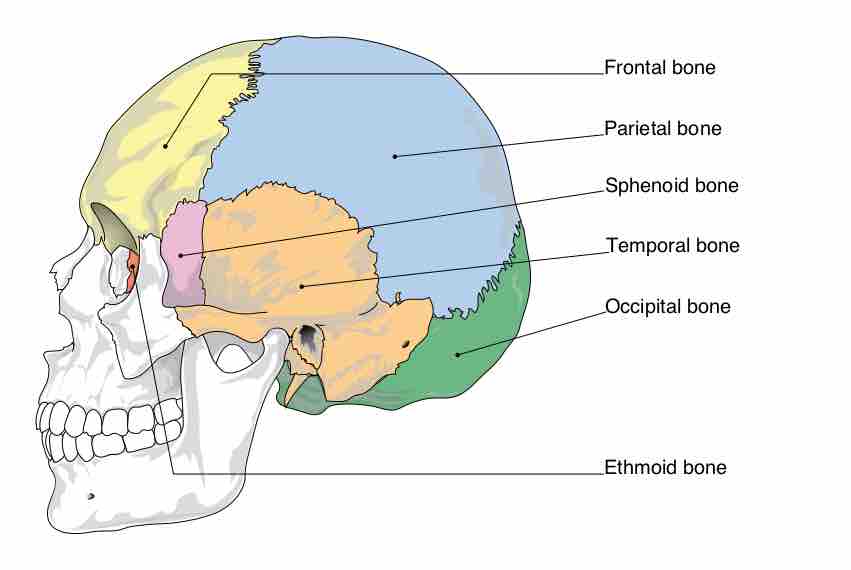The neurocranium forms the cranial cavity that surrounds and protects the brain and brainstem. The neurocranium consists of the occipital bone, two temporal bones, two parietal bones, the sphenoid, ethmoid, and frontal bones—all are joined together with sutures.
Evolutionary ,it is the expansion of the neurocranium that has facilitated the expansion of the brain and its associated developments.

Neurocranium
A lateral view showing the bones that structure the neurocranium.
Occipital Bone
The occipital bone forms the base of the skull at the rear of the cranium. It articulates with the first vertebra of the spinal cord and also contains the foramen magnum, the large opening of the skill through which the spinal cord passes as it enters the vertebral column. The occipital bone borders the parietal bones through the heavily serrated lambdoidal suture, and also the temporal bones through occipitomastoid suture.
Temporal Bones
The temporal bones are situated at the base and sides of the skull, lateral to the temporal lobes of the brain. The temporal bones consist of four regions the squamous, mastoid, petrous and tympanic regions.
The squamous region is the largest and most superior region. Inferior to the squamous is the mastoid region, and fused between the squamous and mastoid regions is the petrous region. Finally, the small and inferior tympanic region lies anteriorly to the mastoid.
There are two processes that originate from the temporal bone:
- The zygomatic process that projects from the lower squamous region and articulates with the zygomatic bone of the cheek.
- The styloid process projects downwards from the interior of the temporal bone and provides attachment for several muscles associated with the tongue.
The temporal bones have four borders:
- The occipitomastoid suture separates the occipital bone and mastoid portion of temporal bone.
- The squamosal suture separates the parietal bone and squama portion of temporal bone.
- The sphenosquamosal suture separates the sphenoid bone and squama portion of temporal bone.
- The zygomaticotemporal suture separates the zygomatic bone and zygomatic process of temporal bone.
Parietal Bones
The two large parietal bones are connected and make up part of the roof and sides of the human skull. The two bones articulate to form the sagittal suture. In the front, the parietal bones form the coronal suture with the frontal bone, and in the rear, the lambdoid suture is formed by the occipital bone. Finally, the squamosal suture separates the parietal and temporal bones.
Sphenoid Bone
The sphenoid bone is situated in the middle of the skull towards the front and forms the rear of the orbit. It has been described as resembling a butterfly due to its wing-like processes. The sphenoid bone is divided into several parts: the body of the bone, two greater wings, two lesser wings, and the pterygoid processes.
The sphenoid bone is one of the most complex in the body due to its interactions with numerous facial bones, ligaments, and muscles. The body that forms the middle of the sphenoid bone articulates with the ethmoid and occipital bone and forms a key part of the nasal cavity; it also contains the sphenoidal sinuses.
The greater wings form the floor of the middle cranial fossa that houses the frontal lobes and pituitary gland, and also the posterior wall of the orbit. The lesser wings project laterally and form the floor of the anterior cranial fossa and the superior orbital fissure through which several key optical nerves pass.
Ethmoid Bone
The ethmoid bone is a small bone in the skull that separates the nasal cavity from the brain. It is lightweight due to its spongy, air-filled construction and is located at the roof of the nose and between the two orbits.
The ethmoid bone forms the medial wall of the orbit, the roof of the nasal cavity, and due to its central location it articulates with numerous bones of the viscerocranium. Inside the neurocranium it articulates with the frontal and sphenoid bones.
Frontal Bone
The frontal bone forms the front of the skull and is divided into three parts:
- Squamous: This part is large and flat and forms the main region of the forehead.
- Orbital: This part lies inferiorly and forms the superior border of the orbit.
- Nasal: this part is smaller and articulates with the nasal bones and maxilla to contribute to the roof of the nose.
The frontal bone borders two other neurocranial bones—the parietal bones through the coronal sutures and the sphenoid bone through the sphenofrontal suture. It also articulates with the zygomatic and nasal bones and the maxilla.